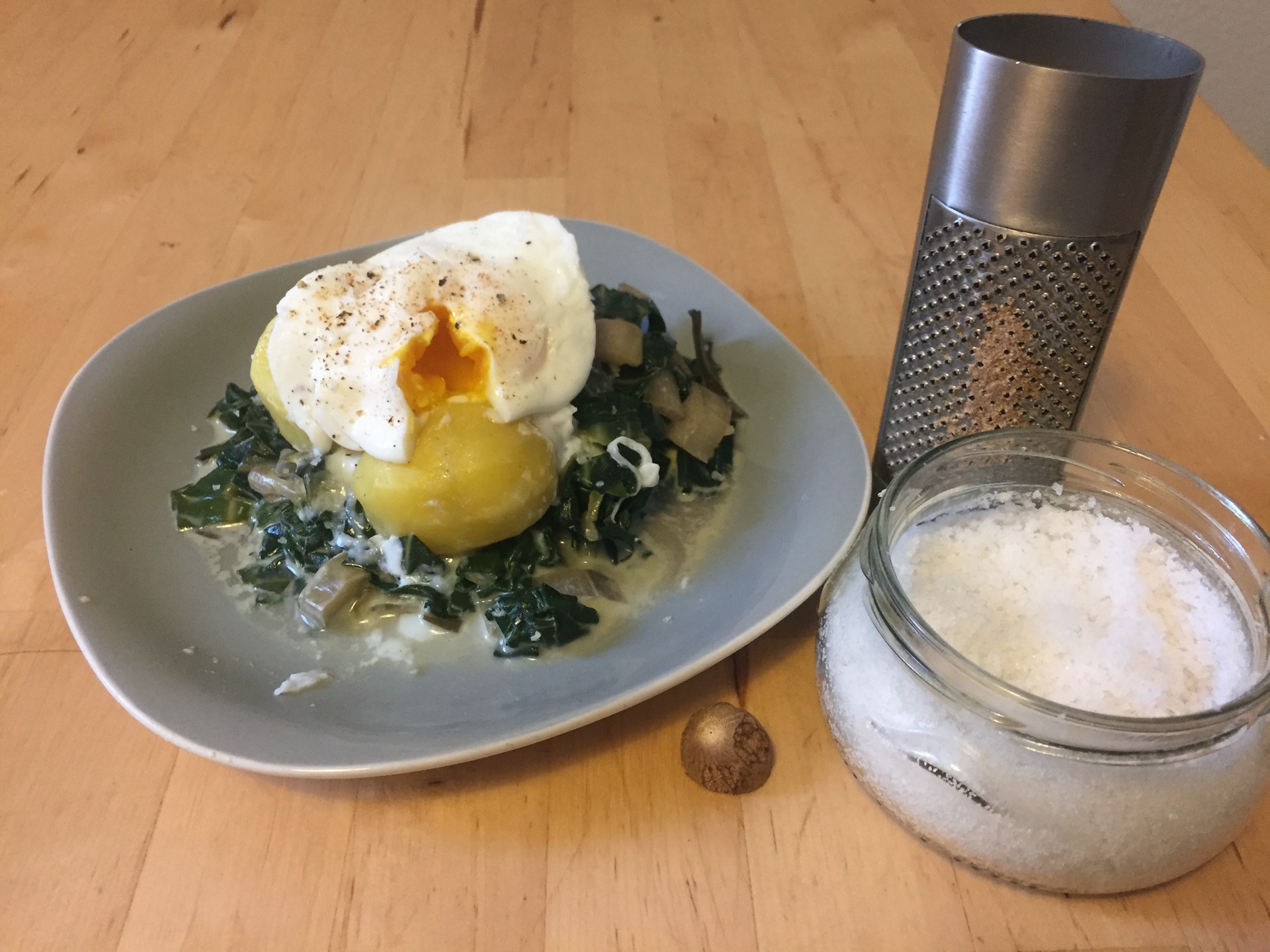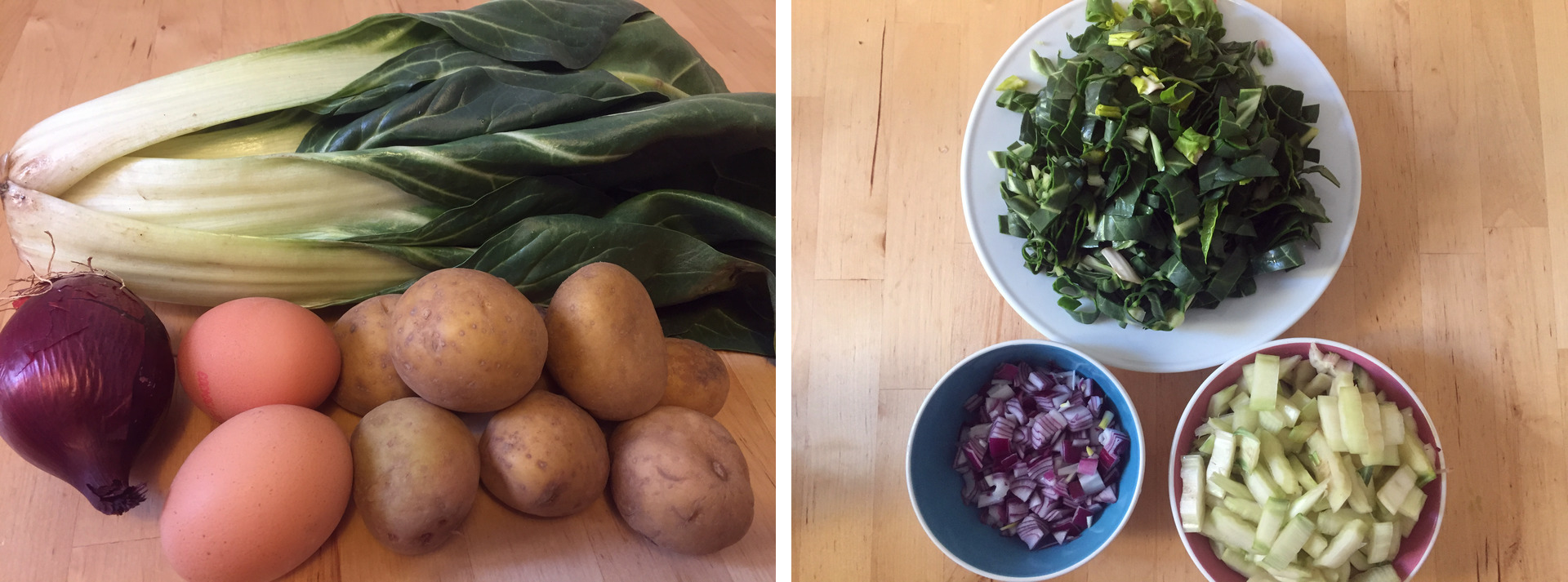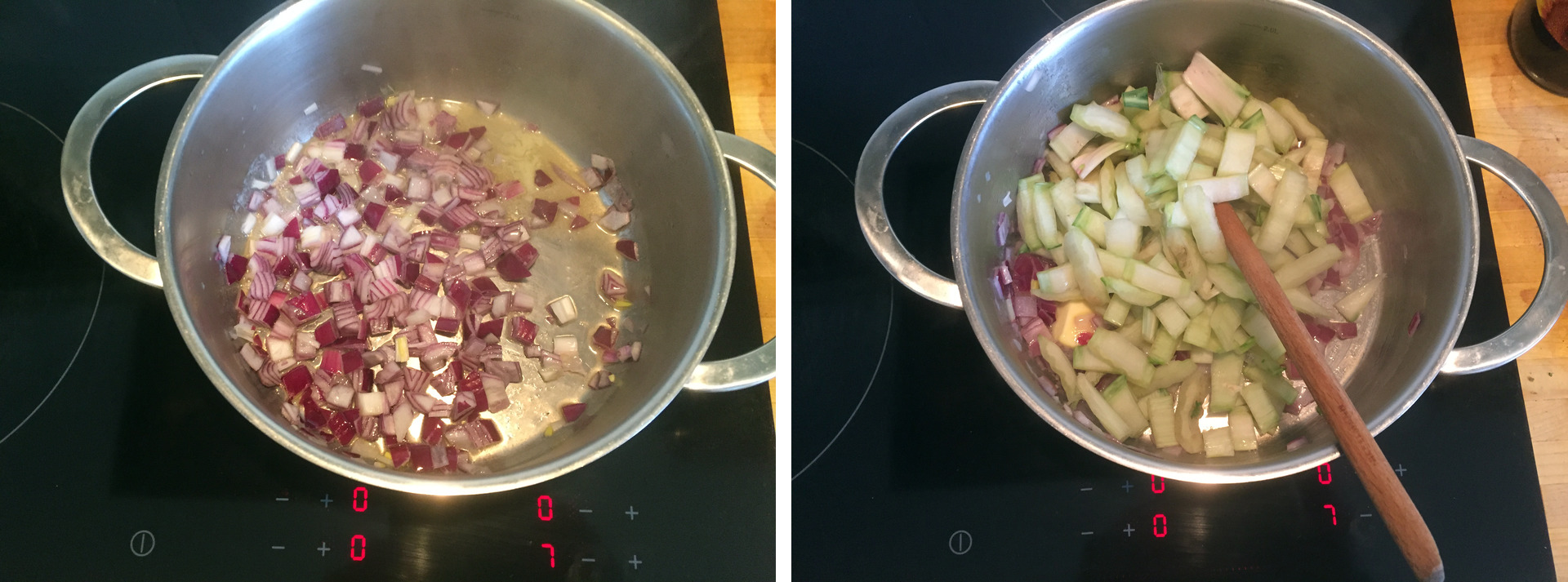Poached Egg With Braised Chard
Chard was mostly missing until recently at Bulgarian greengrocers. But now it is available every now and then. Considering the rareness of the trove, picking the right recipe was a challenge. I opted for the most simple one, the classical variant with boiled potatoes and egg.

Afraid of poaching eggs? Fry them sunny-side-up or scrambled but once you've got the hang of it, poaching is really easy.
Poaching Eggs
There is no shortage of internet advice for perfectly poached eggs. Most of it does not stand up to scrutiny though.
Vinegar?
Vinegar in the cooking water is said to accelerate the coagulation of the egg white. While this is true, it is also true that the eggs will pick up a rather unpleasant vinegar flavor, and they really coagulate by hot water alone, without any vinegar.
Salt?
You also see recommendations for salt in the cooking water. The reasoning behind it is to salt the eggs while cooking. But will they taste any better then? No! Besides, the salt will give the egg white a shabby and ragged look.
Cling Foil?
The weirdest method is attributed to Jamie Oliver. He recommends knotting the eggs into cling foil while cooking. Again, the alleged advantage is the more intensive seasoning of the egg. But what is false for salt is falser for other spices. The delicate flavor of an egg is ruined when buried under spices and herbs. It is best carved out, when the different flavors are well defined and separated in the mouth.
Whirlpool Method
Stirring the hot water vigorously with an egg whisk into a fast rotation and sliding the egg into the whirlpool in the center of the pot has the effect that less egg white is dissolving into the water. The effect is not a supernatural one but it certainly does not hurt.
So What Is The Right Method?
The single most important factor is the freshness of the eggs. It is hard to fail with the freshest of eggs, it is hard to succeed with older ones. When you crack a fresh egg, you have the yolk and the egg white. The older the egg is, the more egg white with low viscosity accrues around the viscous part. And exactly this low viscosity egg white will vanish into the cooking water while poaching, fraying the outline.
I always crack the eggs over a fine sieve. The viscous egg white and the yolk stay in the sieve, while the thin fluid flows through the sieve. The sieve will not turn an old egg into a fresh one but it will greatly improve the process and the losses are close to zero. Whatever flows through the sieve would dissolve into the cooking water anyway.
It is also important to leave the eggs alone. Do not stir, do not try to model the egg white around the yolk! Provided the water has the right temperature (ca. 90 °C) and you have made a nice whirlpool, the eggs will be perfect without any additional measures. Water has a temperature of 90 °C, when it starts steaming and when you see little bubbles rising from the bottom of the pot but before it turns into a rolling boil.
How Long Do the Eggs Need To Cook?
Until they are ready! Just how long that takes exactly heavily depends on the temperature of the water, the size of the eggs and your personal taste. For a quick check, take one egg cautiously with a skimmer and test the stiffness of the yolk. You will often hear that it should have the consistency of mozzarella. For me personally, that would be overcooked.
Provided that the eggs are really fresh, you can poach several of them at once. They usually separate after a minute or two. Otherwise you help along with a knife.
Chard
Chard, blette in French, bietola in Italian or Mangold in German is often considered a welcome alternative to spinach only, although it is a botanic sibling of the sugar beet. In fact, chard roots had been used for sugar production for a long time. When braised, the plant develops a little sweetness that goes very well with the bitter notes of it.
The stems need considerable longer cooking time than the leaves, not only for getting soft. They will also lose their bitterness by cooking. I always cook the leaves alone first, and add the leaves after about two thirs of the total cooking time.
By the way, the exact cooking time has to be found by try and error for your personal taste.
Ingredients

Serves 4.
- 4 eggs
- 1000 g chard
- 2 tbsp butter
- 2 onions
- 100 ml cream
- 500 g starchy potatoes
Preparation
Prepares in approximately 50 minutes
- Cut out the trunk of the chard. Cut off the leaves and wash them.
- Slice the stems (about 1 cm).

- Heat the butter in a pot and sauté the finely chopped onions until transparent.
- Add the stems to the onions and sauté for a short time. Add salt and pepper to taste, 30 ml of hot water, and braise on a low heat for about 20 minutes until soft.

- In the meantime, cut the leaves lengthwise and then into strips of about 1 cm.
- Peel the potatoes and cook them in salt water.
- When the chard stems are done to your taste, add the leaves and braise for about 10 minutes.
- Season with salt, pepper and nutmeg. Add the cream and simmer for a couple of minutes.
- Fill a large pot 8-10 cm with water and heat to about 90 °C.
- Crack the eggs and slide them cautiously into a fine sieve.
- Stir the hot water vigorously with a whisk into fast rotation. Slide the eggs cautiously into the whirlpool.
- Cook the eggs for 3-5 minutes, keeping the water in slow rotation so that the eggs do not stick to the ground of the pot.

The egg on the photo is not completely done. Served at this time, the yolk would slip out of the egg white. - Remove the eggs with a skimmer when done (test with your thumb!) and drain them on a piece of kitchen roll. Season with a little fleur de sel, black pepper and nutmeg. Serve with the vegetables and the potatoes.
Do not remove the skimmer under the egg when draining. Otherwise, the egg will stick to the kitchen roll!
Leave a comment
Giving your email address is optional. But please keep in mind that you cannot get a notification about a response without a valid email address. The address will not be displayed with the comment!